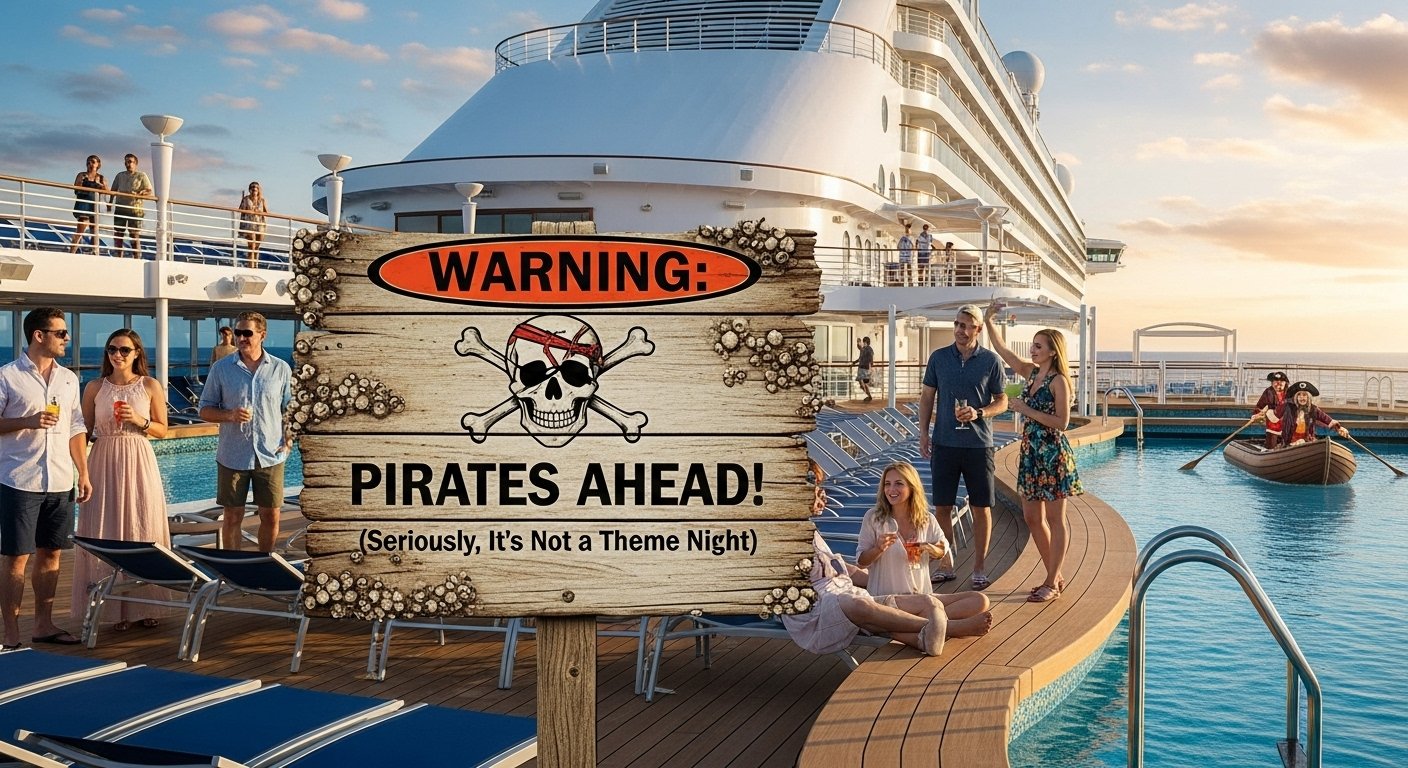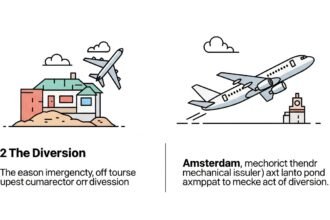Cruising across the blue sea on a luxury cruise sounds like a dream vacation. Fancy dinners, swimming pools, ocean views, and exciting stops at beautiful places make cruises feel like floating hotels. But sometimes, even dream vacations come with real-world safety warnings. One of those serious concerns is piracy at sea. Yes, piracy still exists today, and it can affect even big, fancy cruise ships. That’s why piracy warning luxury cruise passengers are seeing more often is something to take seriously. you might imagine pirates like in old movies—wooden ships and eye patches—but modern pirates are real and dangerous. They often use fast boats and weapons to try to rob ships or take hostages. In this helpful guide, we’ll explain what cruise passengers need to know about modern piracy warnings. We’ll talk about where it’s happening, how ships stay safe, and what you can do to travel confidently. Whether you’re planning a cruise or just curious, this article will make sure you stay smart and safe while enjoying the sea.
What Does “Piracy Warning Luxury Cruise Passengers” Mean?
When cruise lines give a piracy warning to luxury cruise passengers, it means they’re traveling through or near areas where pirate attacks have happened before. These warnings don’t mean danger is certain, but it does mean there’s a possible risk. The cruise company usually informs passengers ahead of time and shares details on how they plan to keep everyone safe. modern piracy is a serious concern in some parts of the world like the Red Sea, Gulf of Aden, Strait of Malacca, and waters near the Horn of Africa. Pirates there often go after big ships like tankers, cargo vessels, and sometimes cruise liners too. They may try to rob the crew or demand ransom. That’s why these warnings matter so much for anyone on board. passengers are usually asked to stay alert, follow crew instructions, and stay calm. The good news is that cruise ships today have strong safety plans in place and train their staff to handle these situations the best they can.
How Common is Piracy Today?
Many people are surprised to learn that piracy is still a problem today, especially near certain sea routes. According to real-time naval data and maritime security reports, there are still dozens of pirate attacks every year. in some years, attacks have gone down a bit thanks to stronger patrols and better defense systems. But in other times, especially when political unrest or poverty increases in certain areas, piracy returns again. cruise ships aren’t usually the top target—most pirates go after slower cargo ships that carry valuable goods. But big cruise liners with rich passengers and lots of equipment can still be attractive to criminals. That’s why a piracy warning luxury cruise passengers get before sailing is never just drama. It’s based on real concerns and helps travelers stay prepared.
Where Are the Most Dangerous Waters for Piracy?
Some oceans and seas are more dangerous than others. Here are a few piracy-prone areas where most cruise lines issue strong warnings:
- Red Sea and Gulf of Aden (off Somalia and Yemen)
- Strait of Malacca (between Indonesia and Malaysia)
- West Coast of Africa (especially near Nigeria)
- Caribbean Sea (this is less common, but small-scale piracy has occurred)
Cruise ships passing through these waters increase their safety measures. That might include turning off external lights, speeding up the journey, or even hiring private security. Many people are surprised to learn that some luxury ships have guards with non-lethal weapons and water cannons to keep pirates away. when booking a cruise, research the route. If it passes through areas known for piracy, the cruise line should clearly share that information and explain how they’ll protect guests.
How Cruise Ships Protect Passengers from Piracy
Cruise lines take passenger safety very seriously, and they have plans ready just in case pirates try to approach the ship. While attacks are rare, precautions are strong. Some of the steps they take include:
- Changing routes if piracy risk increases
- Turning off non-essential lights during night crossings in risky areas
- Hiring security teams to travel onboard
- Doing drills that show what passengers should do during a piracy alert
Ships also communicate closely with naval forces when passing through dangerous waters. In some areas, military ships even escort cruise liners to make sure they stay safe. as a traveler, hearing about these things might be scary. But remember—these steps are done to prevent problems, not because attacks happen often. It’s like locking your doors at home—not a sign of danger, just smart safety.
Pirate Attack Procedures: What Passengers Might Experience
If a cruise ship gets close to pirate-risk areas, the crew may perform a safety drill. This is similar to lifeboat drills or emergency practice sessions you usually do on day one of the cruise.
During a piracy safety drill, here’s what might happen:
- Passengers may be asked to go to an inside area, like their cabin or a hallway
- Windows and doors might be closed and locked
- You may be asked to turn off lights and stay quiet
- The crew will keep updated through loudspeakers
These steps sound dramatic, but they’re all just to lower visibility and avoid attracting attention from pirate boats. It’s a temporary action that helps keep everyone safe. Passengers are reminded not to panic and to listen to the crew’s instructions. if an actual alert happens (which is rare), the crew knows exactly what to do because they train for it often. These drills are an important way to stay ready while keeping everyone calm.
Tips for Passengers Receiving a Piracy Warning
Getting a piracy warning as a luxury cruise passenger may feel scary at first, but there are simple, smart steps you can take to stay safe:
- Don’t panic. These warnings are just part of staying careful. Ships prepare well in advance.
- Ask questions. Cruise directors and crew members are trained to explain what’s happening.
- Learn the safety plan. It will be shared during briefings, emails, or in-room pamphlets.
- Pack wisely. Travel insurance, emergency contact info, and ID should always be kept handy.
Most importantly, trust the process. Luxury cruise ships are operated by professionals who plan for every type of situation, including pirate threats. You’ll feel more peaceful when you understand how everything works.
Should You Cancel a Cruise Because of Piracy?
One important question people ask is, “Should I cancel my cruise if there’s a piracy warning?” The short answer is usually no. piracy warnings are a way for cruise lines to act responsibly. They want you to be informed and prepared—not scared. In most cases, cruise lines will change the route or strengthen security if an area becomes too risky. Ships don’t just sail into danger blindly. also, you can look at past travel records and reviews. Thousands of people cruise every day without any issues. If you’re very worried, talk to the cruise line for details. They often offer options or upgrades to help nervous travelers feel better. having travel insurance is helpful, too. It can cover delays, route changes, or even trip cancellation. But most of the time, the cruise goes ahead safely and smoothly.
Real Stories: When Piracy Became a Real Issue
There have been a few real events where luxury cruise passengers experienced pirate-related trouble. One of the most reported cases happened in 2008, when a luxury cruise liner near Somalia saw suspicious boats approaching. the captain quickly turned off the lights, sped up the ship, and carried out an anti-piracy drill. Thanks to fast thinking and smart planning, nothing bad happened. But the event showed how real piracy warning luxury cruise passengers can be. in many of these stories, the pirates gave up once they realized the ship was too fast or too protected. This shows that cruise teams are trained well and know what to do. These stories serve as both a reminder to be careful and a sign of how strong the safety systems really are.
Expert Advice from Cruise Ship Officials

Many cruise line officials and security experts share helpful advice for passengers. One common message is: knowledge is power. they recommend passengers attend safety briefings and ask about sea routes before booking. Most cruise companies want to keep guests informed and feeling secure. Some even include printed routes so passengers can track their trip each day. security experts usually stress that pirates want easy targets. Cruise ships are large, fast, and hard to board—the least likely targets. With modern radar, secure communication tools, and trained security guards onboard, officials say risk is very low. as a traveler, staying informed and calm is your best way to enjoy your amazing cruise, even if your ship sails near pirate zones.
What Is Maritime Security Like Today?
Modern maritime security is far more advanced than a decade ago. Radar systems, satellite tracking, and ship-to-shore alerts all keep cruise vessels in contact with coast guards and navies.
Some of the latest tech tools include:
- High-speed water cannons to push pirate boats away
- Sound-based weapons called long-range acoustic devices (LRADs)
- Motion sensors near the outer deck
- Guards trained for non-lethal defense
Governments and private companies now work together to patrol high-risk waters. Cruise lines also follow international safety rules from the maritime industry to protect everyone onboard. This all means that if you get a piracy warning, it’s because your cruise line is acting wisely—not because you’re in danger.
How to Stay Calm and Informed on Your Cruise
If you’re on a vacation, the last thing you want is to spend time worrying. When you receive a piracy warning as a luxury cruise passenger, it’s normal to feel nervous—but knowledge keeps fear in check. stay calm by checking updates from your cruise company daily. Most ships provide schedule notes or announcements about the journey. Attend informational sessions or listen to safety videos in your room. you can also read trustworthy cruise blogs or news sites before your trip. Just steer away from social media panic or rumors. Stay focused on the facts and rely on official updates.
Enjoy your cruise the smart way—by being aware, prepared, and relaxed.
FAQs
What is a piracy warning for cruise passengers?
A piracy warning is a safety notice from the cruise line telling guests they may enter areas where modern pirates have operated before.
Are cruises often attacked by pirates?
No. While pirate attacks happen, modern cruise ships are rarely targeted and have strong protection systems.
Is it safe to cruise near high-risk areas?
Yes, if precautions are followed. Cruise lines use careful planning and strong security to keep guests safe.
What should I do if there’s a piracy drill onboard?
Stay calm and follow the crew’s instructions. These drills are for your safety and only last a short time.
Will I get a refund if I feel unsafe due to a piracy warning?
It depends on the cruise line’s policy and your travel insurance. Talk to the cruise company for details.
Can children and families still cruise safely after a piracy warning?
Yes, families cruise safely every day. Just follow safety tips and enjoy your adventure together.
Conclusion
Cruise vacations are an exciting way to see the world, relax, and enjoy new adventures. While the idea of pirates may sound frightening, the truth is that cruise ships are ready for anything. If you’ve received a piracy warning luxury cruise passengers should take to heart, it’s only because cruise lines care about your safety. remember, warnings are tools for preparation—not panic. With smart technology, trained staff, and strong sea laws, luxury cruise lines sail safely even through risky waters. So pack your bags, book your dream cruise, and sail with peace of mind. Keep informed, stay calm, and enjoy the journey. The ocean is calling—and now, you know how to answer wisely.






